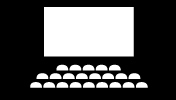

Denmark's entry for the 2023 Oscars is the third feature from Icelandic writer, director, and visual artist Hlynur Pálmason (Winter Brothers, A White, White Day). Set in the late 19th century, the story follows a young Danish Lutheran priest named Lucas (Elliott Crosset Hove) who is sent to Iceland to oversee the establishment of a church in a Danish village and photograph the people of the massive remote island, what was then a Danish territory settled by Viking explorers. The soft, monolingual Lucas travels to Iceland by boat with a group of weathered Icelandic laborers and an all-important translator. Once ashore, they are escorted by a stern local guide named Ragnar (Ingvar Eggert Sigurðsson), who is distrustful of the Danes but curious about Lucas's connection to God.
The harrowing journey up the coastal mountains they embark on is Tarkovskyesque. Pálmason explores spiritual and metaphysical themes as his arrogant, insecure protagonist is challenged by the natural environment and haunted by dreamlike visions. But less than half of this deliberately paced, 142-minute picture is devoted to this trek. Once Lucas arrives at the settlement, where the church is well on its way to completion, Godland almost becomes an entirely different film. Yet watching Lucas attempt to adjust to his new surroundings, with people who are comfortable in the environment and at peace with themselves, explores the themes of the first half from a sideways vantage point. In addition to Tarkovsky, the film recalls Ingmar Bergman's work depicting a man of God whose faith is challenged and Werner Herzog's many films about the price paid by "civilized" men who dare to tame the unforgiving natural world.
Godland also recalls, thematically and visually, Bruce Beresford's 1991 film Black Robe, about a 17th-century Jesuit missionary tasked with building a settlement in the New World and converting the Algonquin Indians to Catholicism, and Lisandro Alonso’s 2014 film Jauja, about a Danish Captain in the 1880s on a quest to find his teenage daughter amongst a seemingly endless and rocky Patagonian landscape. Like Jauja, Godland is photographed in the 1.33:1 aspect ratio and presented with a rounded edge masking that gives the impression that we're looking at a living photographic slide. But, where Jauja employs this technique as a gimmick, it feels motivated and assertive in Godland.
The black-robed Lucas carries a heavy, cumbersome camera and portable darkroom on his back through his journey to document the land and its people. As with most aspects of his time in Iceland, it's a task he feels called to, yet soon becomes frustrated with. In the film's opening, a title card states that a box of seven wet plate photographs was found in Iceland and that these images, the first-ever photographs of the southeast coast, were believed to have been taken by a Danish priest. Hlynur claimed to have used this as the inspiration for his film, though that story is about as true as the one on which Joel and Ethan Coen's Fargo is based.
No matter. The striking images of the priest with his retrofuturistic-looking rook sack traversing Iceland's mountains, rivers, and valleys constantly remind us what a foreign outsider he is in this world. And every time he stops to capture an image, we stop to ponder what both he and his subjects are thinking at the moment. These photographs serve as a narrative and subtextual spine for this most compelling picture. And the photography of the movie itself—by Pálmason’s regular cinematographer, Maria von Hausswolff, who also lensed Annie Baker's Massachusetts-set Janet Planet this same year—is breathtaking. Pálmason and von Hausswolff capture the natural environment in timeless and hypnotic ways. I could stare at this movie for days.
While recalling the work of Andrei Tarkovsky, Ingmar Bergman, Werner Herzog, Lisandro Alonso, and Bruce Beresford, Hlynur Pálmason's film, about a Danish priest sent to build a church in Iceland, has a distinctive tone and magnificent visual imagery.




